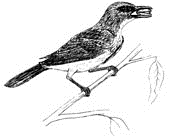Vertebrate Pest Conference: Proceedings

Vertebrate Pest Conference Proceedings: 17th (1996)
Date of this Version
1996
Document Type
Article
Citation
Published in Proceedings: Seventeenth Vertebrate Pest Conference … 1996, ed. Robert M. Timm & A. Charles Crabb (University of California, Davis, 1996).
Abstract
The Conservation Reserve Program (CRP) has produced nearly 600,000 ha of exceptional wildlife habitat in Nebraska. Unfortunately, several species of rodents that inhabit CRP grass fields cause damage to agricultural crops. The emergence of corn seedlings in a 4-row strip of no-till field corn, planted in a 64 ha bromegrass field in northeastern Nebraska was examined. The most common rodent species in the study area was the deer mouse (Peromyscus maniculatus), of which 18 were captured within 10 m of the planted strip during one evening (400 trap nights). Corn seedling emergence in unprotected control areas [x̅ = 19.2 plants/dekameter of row (dor)] appeared to be lower than in areas protected with welded wire exclosures (x̅ = 23.7 plants/dor). An in-furrow application of 2% zinc phosphide pellets (2.75 kg/ha) also contributed to an increase in emergence (x̅ = 21.9 plants/dor). Differences among the treatments, however, were not significant (P = 0.76). Additional research is needed to develop methods to reduce wildlife damage in crop fields that incorporate conservation tillage practices or are adjacent to or converted from CRP fields.
Included in
Animal Sciences Commons, Bioresource and Agricultural Engineering Commons, Environmental Engineering Commons


Comments
Copyright © 1996 (where applicable) by the Vertebrate Pest Council of the Vertebrate Pest Conference. Used by permission.